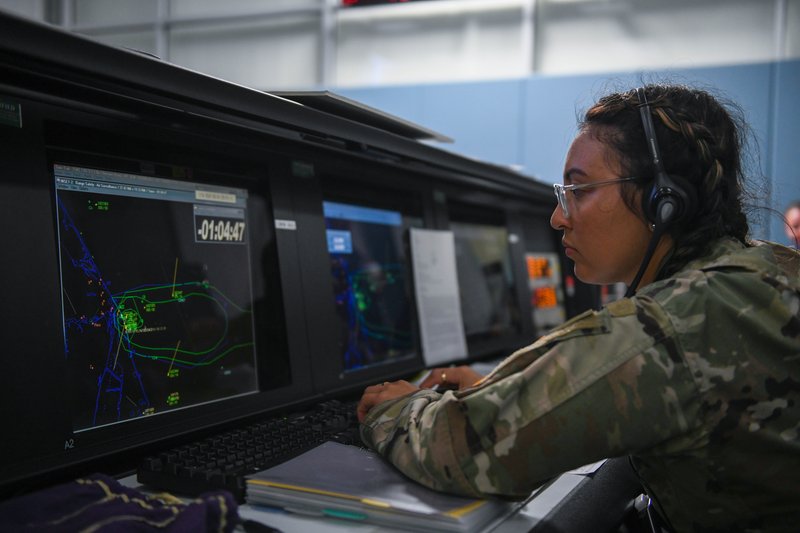The New Battlefield: Space Defence, Emerging Threats, and Strategic Opportunities (Studio)
A Starlink launch at Cape Canaveral, Florida, on 27 February 2023. (Photo: SpaceX)
Brought to you in partnership with EOS
Space is now the predominant military domain, as demonstrated by the role of capabilities such as Starlink in the Ukraine war. However, we are only at the beginning, with new opportunities in surveillance, navigation and communications – and a growing threat of conflict.
That was the theme of ‘The New Battlefield: Space Defence and the Future of Military Operations’, a panel sponsored by defence company Electro Optic Systems (EOS) at Eurosatory 2024.
Rory Welch, vice president for global government and satellite services at satellite communications provider Intelsat, noted the growing importance of space to modern warfare in recent decades and the evolution of military applications in the domain. For instance, he highlighted the importance of precision navigation and timing:
‘That’s ubiquitous across the force, remote sensing for awareness of what’s happening, making decisions, and even things like weather predictions to manage operations,’ Welch argued.
Evolution of Military Applications in Space
He noted that this has been accelerated with the proliferation of capabilities across orbital regimes, from geostationary (GEO) to low earth orbit (LEO). The latter has been a particular focus for rapidly expanding commercial capabilities, perhaps best highlighted by Starlink.
While there are undoubtedly opportunities in space for Western nations and their allies, there are also increasing dangers. Welch pointed to ‘very robust RF interference, cyber interference, even counter-space weapons’.
Pierre-Emmanuel Haensler is head of research at the Surveillance Systems for Aerospace and Defence in ONERA, the French aeronautics, space and defence research lab. He noted the dual nature of many activities in space, which can make capabilities difficult to assess.
For instance, Haensler pointed to in-orbit servicing, which has hugely increased, with a need to conduct activities such as repairs, maintenance and extending the life of satellites, which could result in less debris. This is ‘of course, completely defence related’ because such capabilities could be used in various military activities.
Ben Greene, founder and chief innovation officer of EOS, outlined the huge change in the economics of space launch, with the cost per kg down by a factor of 100 over the past 25 years.
The Data Challenge: Integration and Processing
Greene said he expects to see even more data coming from space from increasing numbers of sensors. The challenge, however, is not in space but on the ground:
‘How are we actually going to integrate the masses of data coming our way and process it effectively and quickly enough to act in a tactically relevant manner?’
The growing accessibility of space has obvious implications for proliferation, with a range of nations developing new or expanding existing space-based capabilities.
However, this is connected to growing interference in space, while ‘the volatility of the environment has changed dramatically’, said Greene.
China and Russia are the two biggest rivals to the US and its allies – across all domains. However, there are major differences between the two powers regarding their behaviour in the space domain.
Juliana Suess, research fellow and space security policy lead at the Royal United Services Institute (RUSI), a UK-based defence and security think tank, said China has consistently invested in space capabilities for years.
China’s Strategic Investments in Space
While the US remains the preeminent power in the domain, China is catching up, she said, intending to be a leading space power by 2045. She noted that the country ‘has a lot to lose in space’.
Suess pointed to a major Chinese anti-satellite weapons test in 2007, which created a mass of debris and prompted condemnation from the international community. ‘China’s reliance on space has grown massively, but they haven’t really used those incredibly disruptive tests since then,’ she noted.
The same has not been true of Russia, which conducted such tests as recently as 2021. This created a mass of debris in LEO, where the International Space Station (ISS) is located.
‘Russia has not been behaving responsibly in space,’ said Suess. ‘I would argue neither has China. But one actor has more to lose than the other.’

Concerns were exacerbated by recent reports that Russia was developing a nuclear weapon to be placed in outer space as a counter-space capability.
However, Suess noted that we still do not know the details of this capability. There are also serious questions over the scenario in which such a weapon could ever be used, which Suess said could only ever be a last resort because of its impact on Russia’s alliances, notably its vital relationship with China.
‘The Russian-Chinese space partnership is alive and well – it certainly would not be after the placement of such an asset in space, and absolutely not after using such an asset.’
The Role of Commercial Operations in Space Defence
The commercialisation of space is fuelling the growing efforts in the domain. In fact, commercial operations will be much more vital to our future in space than we even realise, said Greene.
‘The space domain, like every other domain of modern warfare, runs entirely on the veracity and fidelity of intelligence,’ said Greene.
‘It is intelligence driven. And if you look at the intelligence systems that inform space domain awareness, you will find that they’ve moved from being monolithic – in other words, single, structured, coherent data-gathering systems – to the quite dispersed and diverse data sources [we have] today.’
Perhaps five or six commercial entities easily produce half of the useful space domain awareness data today, Greene said, making a huge contribution to securing space. This boosts the viability of the data used to inform space intelligence conclusions.
Secondly, they ‘allow the more sophisticated organisations, which largely are national organisations, to float higher above what is a sea of raw global common data [and conduct] much more sophisticated space operations in the intelligence domain.’
A range of technologies will drive the future of space as a domain, but Greene highlighted the importance of lasers. He said these can be used to track many thousands of assets with great accuracy, enabling operators to tolerate massively intensified debris fields.
What’s more, the sensor is also a weapon, Greene noted. ‘The same device which tracks [threats] could also mitigate them at the same time – that’s a very useful capability.’
More from Digital Battlespace
-
![Airbus launches final CSO observation satellite for French Armed Forces]()
Airbus launches final CSO observation satellite for French Armed Forces
Airbus was awarded the Composante Spatiale Optique (CSO) contract at the end of 2010. This included an option for a third satellite, which was activated after Germany joined the programme in 2015.
-
![Intelligence advantage: How real-time GEOINT is reshaping military decision-making]()
Intelligence advantage: How real-time GEOINT is reshaping military decision-making
In today’s contested operational environment, adaptability is key. The new Geospatial-Intelligence as a Service (GEO IaaS) solution from Fujitsu and MAIAR empowers militaries by enabling intelligence advantage, combining advanced technology with human expertise to deliver actionable insights.
-
![Israel sets up new department to boost development of AI and autonomy]()
Israel sets up new department to boost development of AI and autonomy
Israel will continue to develop autonomy for its weapons and platforms as it brings together defence personnel, academia and industry.
-
![Clavister contracted to supply cyber protection for CV90s]()
Clavister contracted to supply cyber protection for CV90s
Clavister CyberArmour, an integrated defence cybersecurity system, will be used on BAE Systems Hägglunds’ CV90 platform in deployments with a Scandinavian country, as well as in an eastern European nation.
-
![Lockheed Martin completes tactical satellite demonstration and prepares for launch]()
Lockheed Martin completes tactical satellite demonstration and prepares for launch
The tactical satellite (TacSat) is an intelligence, surveillance and reconnaissance (ISR) system and will participate in exercises in 2025.
-
![AUSA 2024: General Micro Systems adds four new products to the X9 Spider family]()
AUSA 2024: General Micro Systems adds four new products to the X9 Spider family
The airborne three-domain, the two ground-based and the ¼ ATR OpenVPX-based cross-domain systems were engineered to provide real-time security across multi-domain operations.

























